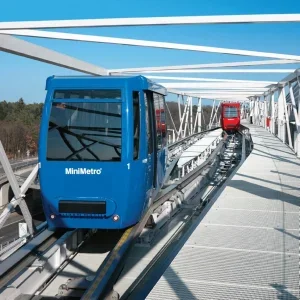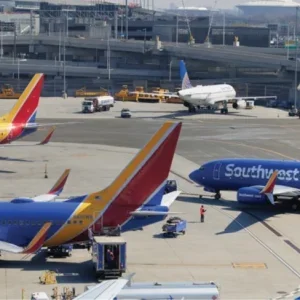In August 2015, 4.3 million people navigated their way through the warren of arrival and departure lounges at Gatwick Airport. It was the hub’s busiest month and, insofar as it experienced no extended periods of delays or cancellations, a singular achievement for an airport with only one runway.
It wasn’t the only ‘busiest ever’ Gatwick trumpeted in 2015. The previous June and July had also been the most crowded on record, and followed on from an announcement made in April that the airport had sustained 26 months of consecutive growth in the number of passengers passing through its two terminals. As such, it has invested markedly in new infrastructure over the past few years to enhance its ability to convey passengers seamlessly to their destinations of choice.
Nowhere has this effort been less in evidence to the casual observer than the baggage handling department, which, of course, is the entire point. Typically, the only instance in which the individual passenger will ever think deeply about their luggage is when it fails to appear at the baggage carousel. That this has not happened frequently during unprecedented levels of foot traffic at the airport is down to the investment it has made over the past decade in technologies that have incrementally improved the speed and security of the baggage handling process.
Lost and found
Since 2006, Matt Payne has helped to oversee the maintenance and improvement works being conducted on Gatwick’s baggage handling systems. In 2013, he was promoted to the role of baggage operational assurance manager on the airport’s Q6 baggage programme.
"Airports experience all sorts of challenges in maintaining such a system," he says. "There’s been a drive across the sector to operate earlier check-ins so that passengers can offload their luggage sooner. Once the bags have been checked-in, then you also have flow constraints downstream, which can be brought about just through the way the whole conveyor system has evolved organically over the years. And then lastly, you have to think about capacity. The operator has to ask themself, ‘Have we got enough make-up positions and output points in the baggage hall that can facilitate the types of luggage handled by the airlines?’"
For the most part, Gatwick’s baggage handling system is much like that of any other airport: where it differs is in its approach in ripping out and rationalising old technology in favour of more efficient and sustainable alternatives. "We’ve looked to move more towards acquiring intelligence from our assets by virtue of condition-based monitoring," explains Payne. "That started back in 2009, when there was a big push for us to acquire a different type of conveyor drive. Historically, we’ve used traditional motors and inverter configurations but we didn’t keep a close enough eye on which ones we used across the whole system. At one point, we had about 1,800 variants of conveyor drive solutions across our estate."
Payne and the Gatwick baggage team have moved to restrict the number of motors, as well as their type. "We now deploy permanent magnetic motors, or ‘PMM’ motors," he says. "They’ve given us the ability to integrate a communications infrastructure within the baggage system, allowing us to collect data on temperature, torque and run-hours from each of the drives. That way, we’re more able to predict when components might fail and deal with the problem proactively, rather than reactively and potentially see the whole system shut down."
The PMM drives are also up to 40% more energy efficient compared with the previous models, their acquisition part and parcel of the airport’s broad ‘decade of change’ initiative to reduce its overall carbon footprint. Part of that plan also involves ripping out some of the older drive variants still in use over in the South Terminal. "There are still a few motor-driven drives over there made up of old chain-driven technologies containing a lot of mechanical moving parts. It’s all very inefficient," Payne adds.
This process began in 2012, when Gatwick installed two Daifuku Logan RF700 sorters in the North Terminal, and another pair thereafter in the South Terminal. The sorters in the former are serviced by four new NERAK S-conveyer lifts. "They were brought in to alleviate height constraints we were experiencing," Payne says. "In the South Terminal, an additional NERAK OOG reciprocated lift was installed for out-of-gauge items, since the building design was impairing our ability to get bags from the check-in level down to the baggage hall environment."
Deployment of these lifts effectively sidestepped that problem and forestalled the need to rely on more conventional conveyor types that would have had to have been built at increasingly sharp angles. The new system is easily able to send through bags at a rate of up to 28 a minute. "Our system is able to sustain a good level of flow without causing disruption at peak times," says Payne. "That necessarily prevents passengers from having to queue for long periods at check-in."
Sort the future
To minimise disruption to the existing system, the impact of each technical addition to the system has to be rigorously simulated. "Our projects and engineering standards call for any principal contractor to provide a virtual model of what it is they have planned for our systems, to allow us to then run bags through those models virtually," says Payne. "From thereon in, we can more clearly discern the throughputs that system is designed to deliver, and map any bottlenecks at merges and junctions that may occur. If we don’t anticipate any disruption, then we can move on to the delivery phase and on-site testing."
This process is also highly beneficial for the suppliers themselves. "It allows them to debug any software or iron out any engineering problems before they even come on site," Payne explains. "A lot of good work has already been done before they arrive on site."
The design of the new baggage handling facility contained with Gatwick’s refurbished Pier 1, due to be opened in early 2016, was entirely simulated in this manner. "We have a whole new luggage sorting system and early bag store there," says Payne. "That will enable us to provide up to 18 hours of advanced baggage check-in for passengers using the South Terminal."
Another £36 million of investment will see the construction of an entirely new automated check-in at the North Terminal, designed to be the largest single ‘bag-drop’ area in the world.
With these new facilities about to open, Payne and his team intend to continue to foster the strong sense of community that has grown between themselves, the suppliers and the airlines, always with the comfort and convenience of passengers in mind.
"My colleagues and I very much want to understand our suppliers’ business models that they use so that we’re better able to optimise their products for use on our systems," he explains. "That way, we’re in a position to best pass those benefits onto the airlines that operate out of Gatwick to give a more holistic, all-round improved experience."






